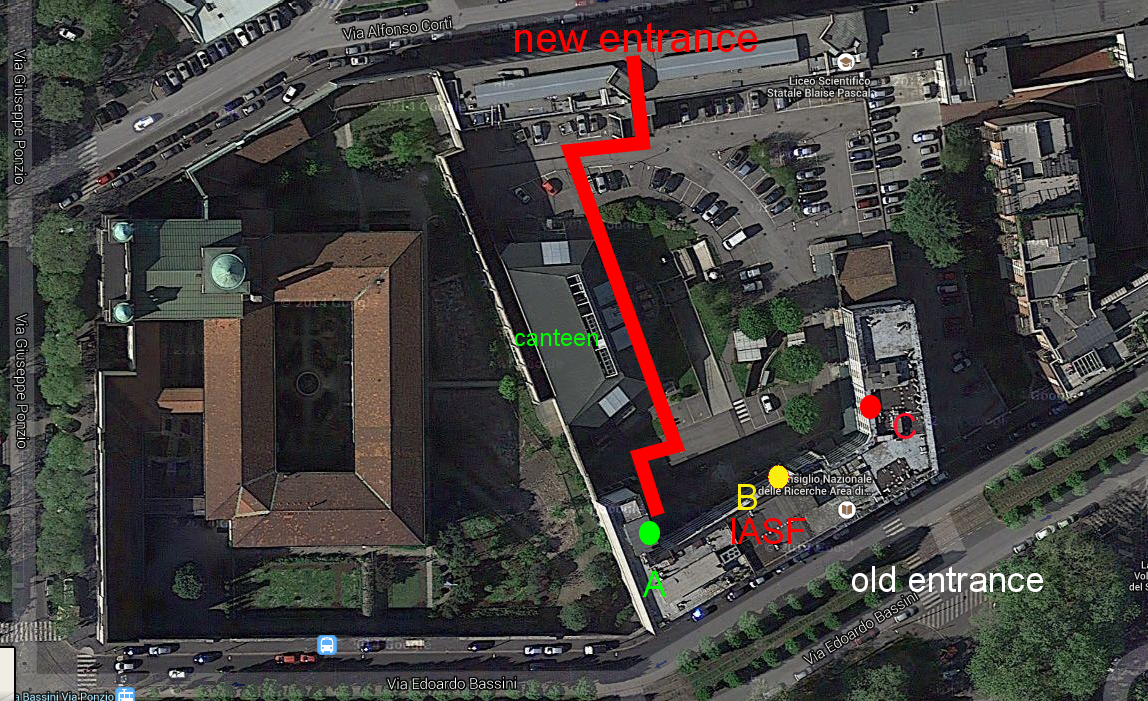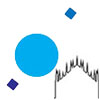Building access
Access to IASF Milano occurs only from the gate in via Alfonso Corti 12. Register at the reception, then (unless your meeting is scheduled in one of the meeting rooms in the Corti building) exit in the yard (see map below) and cross it to reach the Bassini building. Direct road entrance to the Bassini building is no longer possible.
Visitors shall register at the reception. Access to our building occurs through three lifts/staircases: staircase A, green dot; staircase B, yellow dot; staircase C, red dot. Due to construction works in the CNR premises staircases may be accessible or not depending on the status of the works.
The offices and rooms of IASF Milano occupy the entire 4th floor of the Bassini building.
The mechanical workshop (staircase A) and electronics group (staircase B) are in the basement (floor -1).

Public transport
The Institute is easily reachable by public transport, being within walking distance (2-3 blocks) from the Metro Green line (M2) stations of Piola (map) or Lambrate (map). The Lambrate railway station is instead served by some suburban rail lines and very few long distance train.
Attention! In the period 1-31 August 2020 the Metro stations Piola and Lambrate will be closed for maintenance works. Use the replacement bus service or the other bus or trolleybus lines as indicated in this ATM page.
The Metro Green line also serves other railway stations like: Milano Centrale (Central Railway Station), where most long distance trains arrive, and where buses from Linate and Malpensa airports and half of the trains from Malpensa airport have their terminal; Milano Porta Garibaldi (suburban rail lines, some long distance trains and the same trains from Malpensa airport); and Cadorna (Stazione Nord), where trains (Malpensa Express, every 30 minutes) from Malpensa airport, and some suburban lines, arrive.
Trams no. 33 and 19 and trolleybus no. 93 go along via Bassini (stops map).
Info on public transport fares and map is on the ATM website . A day ticket may be a convenient choice.
By air
Milan is served by three airports: Linate, Malpensa and Orio al Serio.
Linate (LIN) is the ‘city’ airport connected to the urban bus network as well as by (more expensive) direct coaches to Central Station; with a standard urban ticket you can get to the institute taking bus 73 and changing to trolleybus 93 (or bus 45, see planner map). Journey by public transport can take from 30 to 40 minutes.
With the opening of the Metro Blue line (M4) between 6 am and 9 pm you can take the Metro at the airport and change to trolleybus 93 at the Argonne station. Changing at the Stazione Forlanini metro station with the S9 train (direction Saronno) alighting at Lambrate is also possible but not advised since S9 runs every 30 min only.
A taxi from Linate to IASF will cost ~20 euros.
Malpensa (MXP, 43 km NW) is the airport where most of intercontinental flights land (Terminal 1). It is also the favourite hub by Easyjet flights from/to Europe (Terminal 2). Connections from/to Malpensa are secured by fast train Malpensa Express, leaving either from Cadorna or Centrale Station (the latter transit also at Porta Garibaldi). There is one train every 15 minutes in peak hours, and the journey lasts from 40 to 55 minutes, according to the train.
Since trains to Cadorna and Centrale alternate, it is advised to catch the first train anyhow: for trains going to Cadorna stay onboard until the terminus and continue by underground as described above; for trains to Centrale it is quicker to alight at Porta Garibaldi and continue by underground too. Tickets can be bought on line here (see also Trenord timetable).
There are also cheaper coaches from/to Central Station. Travel time by bus is approximately 45 minutes, but during day-time on work days may become unpredictable.
Taxis from Malpensa apply a flat fare of 90 euros to anywhere in town.
Orio al Serio (BGY, 43 km NE) is the main airport for RyanAir flights. It is connected to Milan only by coaches to Central station.
By train
Most long distance trains arrive at Milano Centrale; some trains from Turin, Paris or Rome may arrive at Porta Garibaldi. From both stations, you may take Metro Green line, directions ‘Gobba/Gessate/Cologno Nord‘ (roughly 10 minutes). Look at the public transport section above for details. Some trains from Bologna (Rome or Adriatic coast) and Genoa, terminating at either station, may stop also at Milano Rogoredo. In this case you might find convenient to stop there and take a regional train to Lambrate (travel time 5-10 min). See Trenord timetable.
By car
Traffic can be rather dense, even outside peak hours, and parking can be (very) difficult. Public transport are to be preferred over private car. Exits 7 Rubattino or 8a Lambrate on the Tangenziale Est (A51) motorway are the easiest ways to reach the Institute. Follow the signs Centro Citta’ which will take you either in via Bassini (coming from Rubattino) or in via Porpora (coming from Lambrate).
Click for map and driving directions from Rubattino or Lambrate
The institute is not located in the city centre (Area C, congestion charge area) but is located in the new Low Emission Zone Area B (see unofficial explanation in English for vehicles affected).
Taxis
To call a taxi, dial (or use the respective web site) 02 8585, or 02 6969 or 02 4040.
Other institutes in Milan
While in Milan you may want to visit colleagues at other scientific institutions in the area, like
- the Physics Department of the State University is within walking distance (map)
- the historical seat of INAF Brera Observatory is in the city centre easily reachable by underground (map)
- the fastest way to reach the Physics Department of the Milano Bicocca University is to catch a suburban S9 or regional train from Lambrate station (directions). A standard urban ticket is enough.
- the Merate seat of INAF Brera Observatory is 30 km NE, could be reached by train (and walk), or by car.
- IUSS Pavia (30 km S) can be reached by suburban S13 or regional train (directions)
